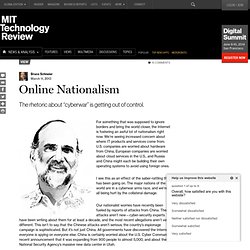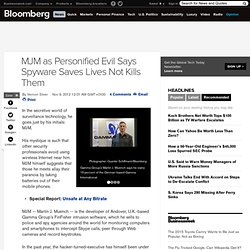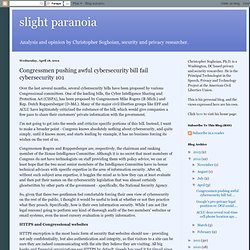

Meet MonsterMind, the NSA Bot That Could Wage Cyberwar Autonomously. Sean Gladwell/Getty Edward Snowden has made us painfully aware of the government’s sweeping surveillance programs over the last year.

But a new program, currently being developed at the NSA, suggests that surveillance may fuel the government’s cyber defense capabilities, too. The NSA whistleblower says the agency is developing a cyber defense system that would instantly and autonomously neutralize foreign cyberattacks against the US, and could be used to launch retaliatory strikes as well.
The program, called MonsterMind, raises fresh concerns about privacy and the government’s policies around offensive digital attacks. Although details of the program are scant, Snowden tells WIRED in an extensive interview with James Bamford that algorithms would scour massive repositories of metadata and analyze it to differentiate normal network traffic from anomalous or malicious traffic. The second issue with the program is a constitutional concern. Cyber-espionage and the Growing New Internet Nationalism. For something that was supposed to ignore borders and bring the world closer, the Internet is fostering an awful lot of nationalism right now.

We’re seeing increased concern about where IT products and services come from: U.S. companies are worried about hardware from China, European companies are worried about cloud services in the U.S., and Russia and China might each be building their own operating systems to avoid using foreign ones. I see this as an effect of the saber-rattling that has been going on. The major nations of the world are in a cyberwar arms race, and we’re all being hurt by the collateral damage. Our nationalist worries have recently been fueled by reports of attacks from China. These attacks aren’t new—cyber-security experts have been writing about them for at least a decade, and the most recent allegations aren’t very different. Unsafe at Any Bitrate News. MJM as Personified Evil Says Spyware Saves Lives Not Kills Them. In the secretive world of surveillance technology, he goes just by his initials: MJM.

His mystique is such that other security professionals avoid using wireless Internet near him. MJM himself suggests that those he meets allay their paranoia by taking batteries out of their mobile phones. Special Report: Unsafe at Any Bitrate. Congressmen pushing awful cybersecurity bill fail cybersecurity 101. Over the last several months, several cybersecurity bills have been proposed by various Congressional committees.

One of the leading bills, the Cyber Intelligence Sharing and Protection Act (CISPA), has been proposed by Congressmen Mike Rogers (R-Mich.) and Rep. Dutch Ruppersberger (D-Md.). Many of the major civil liberties groups like EFF and ACLU have legitimately criticized the substance of the bill, which would give companies a free pass to share their customers' private information with the government. Congress To Amend NDAA To Give DoD & NSA Greater 'Cyberwar' Powers. Remember the NDAA?

Yeah, for a variety of reasons that bill got a lot of attention last year -- mostly focused on the question of detainment of terrorists. But there are some other nuggets in the bill, including one tidbit about "military activities in cyberspace. " Stuxnet cyberweapon looks to be one on a production line, researchers say. Somewhere in the world, the creators of the Stuxnet worm are involved in a cyberweapon manufacturing operation that can pump out supersophisticated malicious software tweaked for specific missions, new targets, and detection evasion.

Skip to next paragraph Subscribe Today to the Monitor Click Here for your FREE 30 DAYS ofThe Christian Science MonitorWeekly Digital Edition Stuxnet, the first military-grade cyberweapon known to the world, has been called a digital missile and a cyber-Hiroshima bomb. But it was not a one-shot blast, new research shows. The platform appears to be able to fire and reload – again and again – to recalibrate for different targets and to bolt on different payloads, but with minimal added cost and effort, say researchers at Kaspersky Labs and at Symantec. Kaspersky, based in Moscow, and Symantec, in Sunnyvale, Calif., are antivirus companies, competitors in fact.
That leaves three launcher files with no known affiliations. Cyber Security Cheat Sheet. Judging the cyber war terrorist threat. On April 1, 2001, an American EP-3E Aries II reconnaissance plane on an eavesdropping mission collided with a Chinese interceptor jet over the South China Sea, triggering the first international crisis of George W.

Bush’s Administration. The Chinese jet crashed, and its pilot was killed, but the pilot of the American aircraft, Navy Lieutenant Shane Osborn, managed to make an emergency landing at a Chinese F-8 fighter base on Hainan Island, fifteen miles from the mainland. Osborn later published a memoir, in which he described the “incessant jackhammer vibration” as the plane fell eight thousand feet in thirty seconds, before he regained control.
The plane carried twenty-four officers and enlisted men and women attached to the Naval Security Group Command, a field component of the National Security Agency. They were repatriated after eleven days; the plane stayed behind. The Navy’s experts didn’t believe that China was capable of reverse-engineering the plane’s N.S.A. Admiral Timothy J. Computers, Freedom, and Privacy in a Networked Society (2010) Massive Chinese Espionage Network.